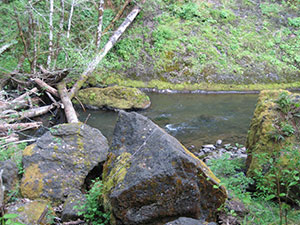 Restoring salmon streams, especially on the coast, has been an Oregon priority for years. Why focus particularly on the coast? Simply, some of the best remaining salmon runs are on coastal streams, and the restoration needs are relatively straightforward. Rather than complexes of dams and reservoirs, most coastal streams suffer from either small impoundments, or the results of careless agriculture, ranching and road-building.
Restoring salmon streams, especially on the coast, has been an Oregon priority for years. Why focus particularly on the coast? Simply, some of the best remaining salmon runs are on coastal streams, and the restoration needs are relatively straightforward. Rather than complexes of dams and reservoirs, most coastal streams suffer from either small impoundments, or the results of careless agriculture, ranching and road-building.
The “restoration economy” as it is being called, provides immeasurable environmental benefits, creates jobs and brings money to struggling local businesses and economies. Ecotrust, in its 2012 study of the restoration economy on the south coast, estimated that between 2000 and 2009 restoration work had created 306 jobs in Coos County and 103 jobs in Curry County. The State spent $39 million on restoration projects in Coos County during that period, and $15 million in Curry County. To carry the figures up the coast a bit, the 2010 statewide Ecotrust study found that Clatsop County in the same period received $63 million in restoration funds, which created 426 jobs; Tillamook County received $44.4 million, which created 296 restoration jobs; and Lincoln County received $19.5 million, creating 138 jobs.
In addition to these benefits, the results of restoration are longterm, and their value increases over time as habitats improve, fish populations rebound and commercial and recreational opportunities expand. This is very obvious in places already heavily dependent on salmon and healthy rivers. The prime coastal example of this is the Rogue River and the economy of Gold Beach. In a 2009 study, EcoNorthwest found that statewide the Rogue River’s salmon runs generate $1.4 million income annually from commercial fishing, and $16 million annually associated with sport fishing. Gold Beach, as the take-off point for Rogue River ventures, has a large stake in maintaining and enhancing the Rogue’s salmon habitat.
Restoring salmon rivers and streams takes a lot of work, and each river or stream is different. Many streams suffer from small-scale dams and poorly designed culverts, both of which act as complete fish barriers. Old culverts need to be replaced with fish-friendly ones, and dams removed. After that, the riparian and riverine habitat restoration is a longterm need requiring local expertise and professional help. Some watershed councils have become adept at designing and completing excellent salmon restoration projects. ORCA works on helping local communities bring restoration discussions to fruition. While ORCA does not have technical restoration expertise, we do have networking and research skills. Please contact Executive Director Cameron La Follette for further information.
DOCUMENTS:
